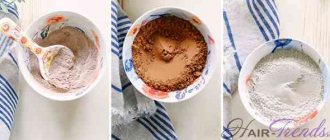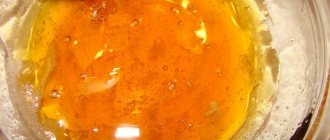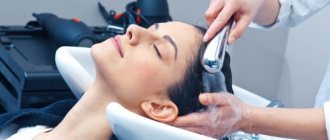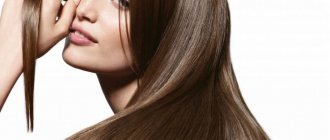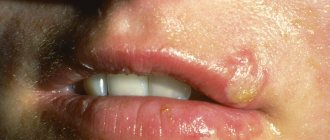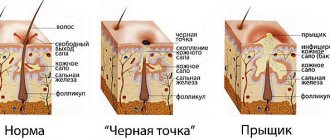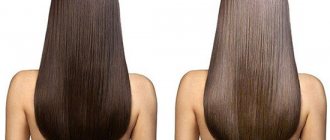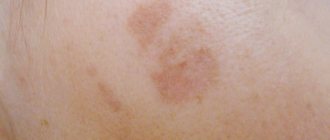Is it possible to remove hair from the nose and ears?
To improve the appearance, sometimes it is necessary to trim or completely remove the follicles. You shouldn’t get too carried away and leave your nasal passage and ears unprotected, everything should be in moderation. It is enough to shorten the eyelashes so that they are not visible to others, but at the same time perform their protective functions.
General contraindications for nasal hair removal
There are a number of contraindications in which removing eyelashes from the nose is prohibited.
- High pain threshold. The nasal mucosa is very sensitive; any sudden movements can cause severe pain.
- Inflammatory processes in the nasal cavity. For example, acne, which can be accidentally touched.
- ARVI and other diseases that cause a runny nose. Mucus contains many harmful bacteria that can enter the body through the wound from torn hair.
- Diabetes.
- Oncology.
- Pregnancy and breastfeeding. The body is more sensitive and susceptible to pain.
- Individual intolerance to drugs.
There are not many contraindications, but to avoid problems, it is better to consult a doctor before the procedure.
Traditional methods
In order to remove ear hair, there are also alternative, folk methods. They usually take a long time, but are inexpensive and suitable for home use.
Peroxide
Suitable for bleaching and gradual removal of ear hair. To avoid burns to sensitive skin, it is recommended to use this method by mixing peroxide with shaving foam in a 1:1 ratio. The foam neutralizes the side effects of peroxide, cooling the skin and protecting it from the aggressive substance.
Rivanol
Being a good antiseptic, rivanol is also an epilating agent. Unlike peroxide and soda, it does not cause burns, but if you are hypersensitive to the medicine, it can cause allergic reactions.
To remove hair, you need to treat the problem area of the skin once a day with a 1% solution of rivanol. The product acts on the hair follicles, causing the hair to weaken and stop growing over time.
It is quite acceptable to remove hair that grows only on the inner surface of the ear only with a trimmer: ears are not legs, perfect smoothness is not needed there, and shaving is enough to forget about the problem for 1-2 weeks.
But if hairs also grow on the auricle, then the safest options that guarantee the absence of stubble are rivanol or hair removal with all its variety of types.
How to remove nose and ear hair at home
There are many ways to get rid of unwanted hair in the nose and ears at home.
Small scissors
Small nail scissors with rounded ends are suitable for hair removal. Such a carved tool is found in every manicure set or sold in pharmacies. The haircut is carried out in front of a mirror in a well-lit room.
- With one hand, pull the tip of your nose up, thereby widening your nostrils. Another, carefully insert the slightly opened scissors inside.
- Cut the hair in a circle, first in one nostril, then in the other.
- Once the process is complete, disinfect your nose with hydrogen peroxide.
The advantages of this method are simplicity, accessibility and painlessness.
Disadvantages are the risk of damage to the membrane or mucosa, as well as frequent repetition of the procedure.
Do not trim the eyelashes that grow deep in the nose; they are not visible to others and are important for the protective functions of the body.
Wax
Wax is often used to remove hair from the nose and ears. Cosmetic stores sell entire kits consisting of strips, an applicator and the working material itself.
Hair removal stages:
- heat the wax to operating temperature;
- then spread it on the applicator;
- press the finished structure to the bottom of the nostril;
- wait one or two minutes until the substance hardens;
- sharply pull the wax applicator out of the nostril.
The same actions are repeated with the ears, but it is better to entrust this process to a master.
The advantages of this method are its effectiveness. Wax removes hairs sticking out of the nose without damaging the mucous membrane.
The disadvantage is that the procedure is painful.
The nostril waxing procedure itself is shown in the video.
Sugaring
An alternative to waxing is sugaring, which can also be used to remove hair from the nose and ears.
- heat the sugar paste to the temperature indicated on the package;
- then place a small amount of the product to the bottom of the nostril;
- when the mass hardens a little, pull it sharply in the direction of hair growth;
- unwanted hairs will come off along with the paste;
- After completing the procedure, treat the nasal passage with an antiseptic and lubricate it with moisturizer.
The same manipulations are carried out on the ears.
In the video, the process of hair removal using sugar paste is shown in more detail.
Sugaring does an excellent job of removing protruding eyelashes, but during the procedure it will not be very pleasant.
Since the mixture contains allergenic bee products, test the product on the crook of your elbow to avoid irritation.
Trimmer
An electric nose and ear trimmer is used more often than other hair removal methods. Most trimmers operate on batteries. Additionally, built-in lighting simplifies the procedure, and the round and smooth nozzle prevents injury to the mucous membrane.
The process of cutting eyelashes:
- turn on the trimmer;
- insert it into one nostril;
- shave your hair using gentle rotational movements;
- repeat the steps for the other nostril.
Additional recommendations for removing eyelashes with a trimmer will help make the process easier.
- The machine and attachments must be disinfected with alcohol or peroxide before the procedure.
- You also need to prepare your nose; to do this, it is washed with water and wiped with a napkin.
- Don't forget to treat your nasal cavity with peroxide and emollient cream after you get your haircut.
- Monitor the battery charge; if the power of the machine drops, it will begin to pull out hairs rather than cut them.
- Avoid hair removal with this device if you have a cold or a nasal problem.
Typically men use trimmers. They like the simplicity of the procedure and the speed of follicle removal, as well as the minimal risk of injury.
Among the disadvantages, users note the need for regular disinfection of the device and its rather high cost. Watch the video to understand the technology of using a trimmer.
Tweezers
To remove unnecessary vegetation you should:
- stand in front of a mirror in a well-lit room;
- lift the end of your nose with your left hand, opening the nostrils wider;
- Grab the hairs tightly with tweezers and pull them out sharply.
In general, cosmetologists do not recommend using this method, as it is extremely painful and can cause inflammation or damage blood vessels.
A nasal depilator is also suitable for hair removal; its operating principle resembles tweezers, only the follicles are grabbed and pulled out not manually, but mechanically.
Bulldog jaws
The most common cause of this phenomenon is the combined effect of gravity and a decrease in collagen content in the skin. If you don't want to look like a bulldog, start taking care of your teeth too. When you lose teeth, your jaw tightens, the skin in that area sags, and wrinkles appear.
That's why it makes sense to invest in a good electric toothbrush, such as the Oral-B 7000, which provides a massage effect and keeps your teeth and jaws healthy. Today, brushing your teeth with a regular toothbrush is like cleaning the carpet with a rag instead of using a vacuum cleaner.
Permanent hair removal from nose and ears
You can remove unwanted hairs not only at home, but also in beauty salons. Cosmetologists offer clients several types of hair removal.
Cool hair removal
The most popular method of nasal hair removal is body hair removal. It differs from a laser procedure in that the device does not heat the skin, hence the name “cold method”.
During the procedure, the cosmetologist carefully places a special device in the nose and turns it on. The beam painlessly penetrates the skin, where it destroys the blood vessels that provide nutrition to the hair follicle. After exposure to the laser, the follicles die and then simply fall out.
The big advantage of laser hair removal is the long-term results, but 4-7 procedures are required to achieve the desired effect. To see how easy laser hair removal is, watch the video.
Enzyme hair removal
If wax and trimmer get rid of hairs for just a month, then enzyme hair removal can eliminate them forever. The procedure for removing unwanted vegetation consists of two stages:
- First, the cosmetologist removes hairs in the usual way, for example, using wax or sugar paste.
- Then a special chemical composition is applied to the skin. It contains the enzymes trypsin and chymotrypsin, they enter the place of empty hair follicles and destroy them.
At first, the hairs will grow back, but after 5 procedures the growth rate will noticeably drop. You can completely get rid of hair in your nose and ears in six months.
Preventive actions
To prevent hair growth in the ears, hygiene procedures should be carried out regularly. It is allowed to clean the outer part of the ear with cotton wool or a clean cloth soaked in warm water or a disinfectant solution. Do not use cotton swabs, which can damage the eardrum and structures of the inner ear.
When carrying out hygiene procedures, do not use sharp objects that can injure the skin. Do not try to remove hair that grows on the inside of the ear yourself. You could seriously injure yourself.
If increased hair growth in the ears is combined with insomnia, loss of appetite, weakness and dizziness, then you should immediately consult a doctor. The listed symptoms may indicate the development of various diseases. If a man is undergoing hormonal therapy, then he must take medications in strict compliance with the dosages prescribed by the doctor.
Which method is painless and effective?
Hair grows in the ears and nose because nature intended it to. But people get rid of them to conform to fashion and look neat. At home, the safest and most effective methods are a trimmer and scissors, but they only shorten the hairs. Therefore, the procedure will need to be repeated often.
For those who can tolerate a little pain, waxing and sugaring are suitable options. Since the sticky stuff uproots the follicles, it will take longer for them to grow back.
If you want to remove excess nasal hair for a long time, then you should contact a cosmetology center, where they can do cool hair removal for the nose or electrolysis for the ears. After several painless sessions, the hair follicles will stop growing.
Six signs of aging
Like England's defeat at Euro 2016, aging is something you don't expect, but when it happens you accept that it's inevitable. This does not mean that there is nothing you can do to prevent old age from catching up with you a little later.
Of course, old age does not spare anyone, but how quickly you grow old depends only on you. A surgical facelift is not the only way to combat old age (look at Mickey Rourke). There are several other ways to delay the time when you will be called grandpa.
Here are six obvious signs of aging and tips on how to, if not avoid them, at least delay their appearance.
How to help a child?
If complications arise, the child should be treated by a doctor. Unauthorized prescription of drugs, especially antibiotics, is unacceptable. All that parents can do is treat the wound with an antiseptic without alcohol and take their daughter to an appointment with a pediatrician, who will decide whether the earrings need to be removed and immediate treatment started, or whether the child can be helped without removing the jewelry from the lobes.
safety measures that all parents can take will help reduce the likelihood of negative complications
- a small child cannot understand the full value of an object inserted into his ears, and therefore you need to be more careful that the baby does not try to remove the earrings;
- you should buy earrings with a reliable and strong clasp to prevent spontaneous opening of the earring, because a small child can swallow or inhale it;
- You should not buy your child earrings with pendants and pointed elements, this will only increase the likelihood that the child will catch the earrings on a toy or something else, pull and severely injure the earlobe until it completely ruptures;
- earrings should not contain nickel, otherwise there is a high probability of developing an allergic reaction.
Possible complications
There are usually no negative consequences when a child’s ears are pierced if the mother did everything responsibly and correctly - she took her daughter to a good licensed clinic, the punctures were done in sterile conditions with sterile instruments, and the subsequent care was correct and thorough. However, even with proper care, a child’s ears sometimes fester after a piercing. This indicates that the wound has become infected. A small amount of pus that is released during treatment or during movement of the earring in the ear should not cause serious concern. It is enough to additionally lubricate such a wound several times with Levomekol or Baneocin ointment.
If the ears are very festered, the earlobes look very swollen and are painful on palpation, if the skin has changed color and has become purple or grayish, you should definitely show the child to a doctor. The temperature after ear piercing sometimes rises, as people say, “due to nervousness.” But if the temperature rise did not occur immediately upon returning from the cosmetologist’s office, but a few days later, against the background of suppuration, then this also indicates either the addition of a bacterial infection
, or that
the child’s body “does not accept” a foreign body
, and the immune system rejects the earrings with all its might.
If the ear is inflamed and red, but there is no pus, this may indicate a possible allergic reaction to some component of the alloy from which the jewelry is made. Ignoring the contraindications that exist for piercing can lead to complications from a vulnerable organ or body system. If the child suffered from otitis media before the manipulation, and the parents still decided to pierce his ears, then deterioration in the hearing organs is possible. The wounds do not heal for a long time and can become very inflamed in children with diabetes mellitus and diseases of the cardiovascular system.
Ophthalmologists say that an incorrectly chosen puncture point, if it is shifted down towards the cheeks, can lead to decreased vision and even the development of glaucoma.
The likelihood of complications is also affected by the time of year. In the summer heat, the child sweats more, it is dusty outside, which increases the likelihood of suppuration and inflammation. In winter, another problem awaits the baby - the effect of cold on pierced ears also does not have the best effect on the healing of the wound. In addition, during the cold season, children wear hats, scarves and sweaters; mechanical injury to the ear is possible if the earring gets caught on clothing.
It is best if the rehabilitation process after piercing falls in May or September.
